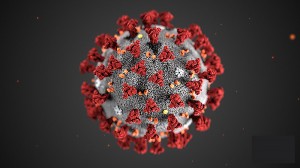오늘의 한마디
COVID-19: Social Distancing (newsletter)
March 27, 2020
As the world struggles to deal with the ongoing COVID-19 pandemic, a practice called social distancing is being implemented to slow the spread of the disease. Social distancing describes the effort to limit direct human contact and increase the physical space between people to avoid spreading a contagious disease. Social distancing is most effective against illnesses that can be transmitted by coughing or sneezing, direct or indirect physical contact, or through the air. COVID-19 is a coronavirus that causes a pneumonia-like disease. Coronaviruses are types of viruses that cause the common cold and other diseases of the upper respiratory system.

On March 20, 2020, train passengers wearing protective masks sit in designated areas to ensure social distancing in Palembang, the capital of the Indonesian province of South Sumatra. Credit: ABDUL QODIR/AFP via Getty Images
Social distancing requires the limiting of non-essential travel and large group gatherings. Authorities have suggested keeping a distance of 6 feet (roughly 2 meters) from other people in public. Social distancing also calls for the closing of such public gathering places as schools, restaurants, museums, and many offices and stores. A widespread policy of social distancing to counteract COVID-19 began in many places the second week of March 2020.

This illustration of Coronavirus Disease 2019 (COVID-19) shows the spikes on the outer surface of the virus that appear as a corona, giving the virus its name. Credit: Centers for Disease Control and Prevention (CDC)
Another aspect of the social distancing strategy requires that people who may have been exposed to a contagious disease isolate themselves, or self-quarantine. People in quarantine for COVID-19 must first follow the standard hygiene rule of washing their hands frequently. But they must also refrain from sharing towels or eating utensils, they must remain at home, they should not have visitors (except as needed to receive care), and they should follow the 6-feet (2-meter) distance rule with family members. Self-quarantine lasts for a period of at least two weeks. That amount of time allows people to know whether or not they have the coronavirus and if they are contagious to other people. After the period of self-quarantine, if the person does not show symptoms of COVID-19, they can return to their normal routine. For those that do have the coronavirus, they must then continue a longer period of isolation at home or in a hospital or other health care facility.
Social distancing can help flatten the curve, an expression that describes curbing of the rate at which people become infected by COVID-19. On a line graph, a sudden surge in cases of illness over a short time appears as a tall, narrow curve. On a similar graph, the same number of cases dispersed over a longer period of time appears as a longer, flatter curve. Ideally, social distancing will flatten the curve by slowing the numbers of people infected by COVID-19. Flattening the curve helps to avoid having more sick people than can be treated effectively at any one time.
COVID-19 is the name of a respiratory disease that was first recognized in human beings in the Chinese city of Wuhan in December 2019. The disease was given the temporary name 2019-nCoV, for novel (new) coronavirus of 2019. It was later officially named COVID-19. The virus that causes the disease was named SARS-CoV-2. Its symptoms include breathing difficulties, coughing, and fever. On March 11, 2020, The World Health Organization (WHO) declared COVID-19 a global pandemic—that is, a disease that has spread over an extremely wide geographic area. By mid-March, the virus had caused more than 8,200 deaths, and more than 200,000 cases had been confirmed worldwide. More than 150 countries have reported cases of COVID-19.
https://www.worldbookonline.com/student/behindheadline?p=44835